- NASA has selected Ball Aerospace and Technologies Corp. of Boulder, Colo., to develop the Operational Land Imager instrument for the Landsat Data Continuity Mission (LDCM). The instrument will capture images in the visible and near-infrared spectra. The cost-plus-award-fee contract, including all options, is $127.9 million.
Under the contract terms, Ball Aerospace will design, develop, fabricate and integrate one flight-model Operational Land Imager. The company also will test, deliver and provide post-delivery support and five years of on-orbit support for the instrument. There are five one-year options for the extension of basic on-orbit support. If all options are exercised, the potential period of performance would extend through 2021. The work will be performed at Ball Aerospace’s facility in Boulder.
The Landsat Data Continuity Mission is the successor to Landsat 7. It is scheduled for launch no earlier than July 2011. Landsat satellites have captured multi-spectral images of the global land surface continuously since the launch of Landsat 1 in 1972. The Landsat data archive is the longest record of land surface as viewed from space. LDCM will detect and characterize changes on the global land surface at a scale where natural and man-made causes of change can be detected and differentiated.
NASA’s Goddard Space Flight Center, Greenbelt, Md., procures and manages the acquisition of the LDCM in partnership with the U.S. Geological Survey (USGS). NASA will turn over management of the LDCM satellite to USGS after launch and on-orbit checkout.
For information about the Landsat Data Continuity Mission, visit:
http://ldcm.nasa.gov






